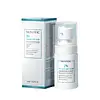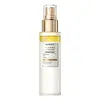What's inside
What's inside
 Key Ingredients
Key Ingredients

 Benefits
Benefits

 Concerns
Concerns

No concerns
 Ingredients Side-by-side
Ingredients Side-by-side

Water
Skin ConditioningButylene Glycol
HumectantPentylene Glycol
Skin ConditioningBetaine
HumectantTranexamic Acid
AstringentNiacinamide
SmoothingAlpha-Arbutin
AntioxidantIsononyl Isononanoate
EmollientCyclopentasiloxane
EmollientPEG-32
HumectantCyclohexasiloxane
EmollientDimethicone/PEG-10/15 Crosspolymer
Ectoin
Skin ConditioningHydroxyethylpiperazine Ethane Sulfonic Acid
BufferingAllantoin
Skin ConditioningCentella Asiatica Extract
CleansingSodium Hyaluronate
HumectantBis-PEG/PPG-20/5 PEG/PPG-20/5 Dimethicone
EmulsifyingMethoxy PEG/PPG-25/4 Dimethicone
EmulsifyingSoy Amino Acids
Skin ConditioningAcetyl Glucosamine
Skin ConditioningCeramide EOP
Skin ConditioningCeramide Ns
Skin ConditioningCeramide NP
Skin ConditioningCeramide AP
Skin ConditioningGlycyrrhiza Glabra Root Extract
BleachingCeramide As
Skin ConditioningArginine
MaskingGalactomyces Ferment Filtrate
HumectantDecarboxy Carnosine Hcl
Skin ConditioningHydrolyzed Sodium Hyaluronate
Skin ConditioningTocopherol
AntioxidantErgothioneine
AntioxidantNonapeptide-1
Skin ConditioningOligopeptide-1
Skin ConditioningHexapeptide-2
BleachingHexapeptide-9
Skin ConditioningSodium Acetylated Hyaluronate
HumectantSodium Hyaluronate Crosspolymer
HumectantCitrus Reticulata Fruit Extract
Skin ProtectingCarbenia Benedicta Extract
Skin ConditioningHydrogenated Lecithin
EmulsifyingPalmitoyl Tripeptide-1
Skin ConditioningPalmitoyl Tetrapeptide-7
Skin ConditioningGlyceryl Stearate
EmollientSodium Polyglutamate
HumectantPolyacrylate Crosspolymer-6
Emulsion StabilisingEthylhexylglycerin
Skin ConditioningHydroxyphenyl Propamidobenzoic Acid
Skin ConditioningDipropylene Glycol
HumectantSodium Citrate
BufferingCetyl-Pg Hydroxyethyl Palmitamide
Skin ConditioningCarbomer
Emulsion StabilisingCholesterol
EmollientGlycerin
Humectant1,2-Hexanediol
Skin ConditioningPropanediol
SolventPotassium Sorbate
PreservativePhenoxyethanol
PreservativeSodium Lactate
BufferingPolysorbate 20
EmulsifyingWater, Butylene Glycol, Pentylene Glycol, Betaine, Tranexamic Acid, Niacinamide, Alpha-Arbutin, Isononyl Isononanoate, Cyclopentasiloxane, PEG-32, Cyclohexasiloxane, Dimethicone/PEG-10/15 Crosspolymer, Ectoin, Hydroxyethylpiperazine Ethane Sulfonic Acid, Allantoin, Centella Asiatica Extract, Sodium Hyaluronate, Bis-PEG/PPG-20/5 PEG/PPG-20/5 Dimethicone, Methoxy PEG/PPG-25/4 Dimethicone, Soy Amino Acids, Acetyl Glucosamine, Ceramide EOP, Ceramide Ns, Ceramide NP, Ceramide AP, Glycyrrhiza Glabra Root Extract, Ceramide As, Arginine, Galactomyces Ferment Filtrate, Decarboxy Carnosine Hcl, Hydrolyzed Sodium Hyaluronate, Tocopherol, Ergothioneine, Nonapeptide-1, Oligopeptide-1, Hexapeptide-2, Hexapeptide-9, Sodium Acetylated Hyaluronate, Sodium Hyaluronate Crosspolymer, Citrus Reticulata Fruit Extract, Carbenia Benedicta Extract, Hydrogenated Lecithin, Palmitoyl Tripeptide-1, Palmitoyl Tetrapeptide-7, Glyceryl Stearate, Sodium Polyglutamate, Polyacrylate Crosspolymer-6, Ethylhexylglycerin, Hydroxyphenyl Propamidobenzoic Acid, Dipropylene Glycol, Sodium Citrate, Cetyl-Pg Hydroxyethyl Palmitamide, Carbomer, Cholesterol, Glycerin, 1,2-Hexanediol, Propanediol, Potassium Sorbate, Phenoxyethanol, Sodium Lactate, Polysorbate 20
Bifida Ferment Filtrate
Skin ConditioningLactobacillus Ferment
Skin ConditioningIsododecane
EmollientButylene Glycol
HumectantDiphenylsiloxy Phenyl Trimethicone
Skin ConditioningGlycerin
HumectantSqualane
EmollientPEG/PPG/Polybutylene Glycol-8/5/3 Glycerin
HumectantNiacinamide
SmoothingCentella Asiatica Leaf Extract
Skin ConditioningOlea Europaea Leaf Extract
PerfumingPolyglycerin-10
HumectantWater
Skin Conditioning1,2-Hexanediol
Skin ConditioningThermus Thermophillus Ferment
Skin ConditioningEctoin
Skin ConditioningPanthenol
Skin ConditioningHydroxyacetophenone
AntioxidantSodium Chloride
MaskingSodium Hyaluronate
HumectantHippophae Rhamnoides Fruit Oil
Skin ProtectingAroma
Hexylene Glycol
EmulsifyingSaccharide Isomerate
HumectantCaprylhydroxamic Acid
Citric Acid
BufferingSodium Citrate
BufferingBifida Ferment Filtrate, Lactobacillus Ferment, Isododecane, Butylene Glycol, Diphenylsiloxy Phenyl Trimethicone, Glycerin, Squalane, PEG/PPG/Polybutylene Glycol-8/5/3 Glycerin, Niacinamide, Centella Asiatica Leaf Extract, Olea Europaea Leaf Extract, Polyglycerin-10, Water, 1,2-Hexanediol, Thermus Thermophillus Ferment, Ectoin, Panthenol, Hydroxyacetophenone, Sodium Chloride, Sodium Hyaluronate, Hippophae Rhamnoides Fruit Oil, Aroma, Hexylene Glycol, Saccharide Isomerate, Caprylhydroxamic Acid, Citric Acid, Sodium Citrate
Ingredients Explained
These ingredients are found in both products.
Ingredients higher up in an ingredient list are typically present in a larger amount.
1,2-Hexanediol is a synthetic liquid and another multi-functional powerhouse.
It is a:
- Humectant, drawing moisture into the skin
- Emollient, helping to soften skin
- Solvent, dispersing and stabilizing formulas
- Preservative booster, enhancing the antimicrobial activity of other preservatives
Butylene Glycol (or BG) is used within cosmetic products for a few different reasons:
Overall, Butylene Glycol is a safe and well-rounded ingredient that works well with other ingredients.
Though this ingredient works well with most skin types, some people with sensitive skin may experience a reaction such as allergic rashes, closed comedones, or itchiness.
Learn more about Butylene GlycolEctoin is a compound found naturally in some species of bacteria. It can be synthetically created for skincare use.
This ingredient is an osmolyte; Osmolytes help organisms survive osmotic shock (it protects them from extreme conditions). It does this by influencing the properties of biological fluids within cells.
When applied to the skin, ectoin helps bind water molecules to protect our skin. The water forms a sort of armor for the parts of our skin cells, enzymes, proteins, and more.
Besides this, ectoin has many uses in skincare:
A study from 2004 found ectoin to counteract the damage from UV-A exposure at different cell levels. It has also been shown to protect skin against both UV-A, UV-B rays, infrared light, and visible light.
Studies show ectoin to have dual-action pollution protection: first, it protects our skin from further pollution damage. Second, it helps repair damage from pollution.
In fact, ectoin has been shown to help with:
Fun fact: In the EU, ectoin is used in inhalation medication as an anti-pollution ingredient.
Ectoin is a highly stable ingredient. It has a wide pH range of 1-9. Light, oxygen, and temperature do not affect this ingredient.
Learn more about EctoinGlycerin is already naturally found in your skin. It helps moisturize and protect your skin.
A study from 2016 found glycerin to be more effective as a humectant than AHAs and hyaluronic acid.
As a humectant, it helps the skin stay hydrated by pulling moisture to your skin. The low molecular weight of glycerin allows it to pull moisture into the deeper layers of your skin.
Hydrated skin improves your skin barrier; Your skin barrier helps protect against irritants and bacteria.
Glycerin has also been found to have antimicrobial and antiviral properties. Due to these properties, glycerin is often used in wound and burn treatments.
In cosmetics, glycerin is usually derived from plants such as soybean or palm. However, it can also be sourced from animals, such as tallow or animal fat.
This ingredient is organic, colorless, odorless, and non-toxic.
Glycerin is the name for this ingredient in American English. British English uses Glycerol/Glycerine.
Learn more about GlycerinNiacinamide is a multitasking form of vitamin B3 that strengthens the skin barrier, reduces pores and dark spots, regulates oil, and improves signs of aging.
And the best part? It's gentle and well-tolerated by most skin types, including sensitive and reactive skin.
You might have heard of "niacin flush", or the reddening of skin that causes itchiness. Niacinamide has not been found to cause this.
In very rare cases, some individuals may not be able to tolerate niacinamide at all or experience an allergic reaction to it.
If you are experiencing flaking, irritation, and dryness with this ingredient, be sure to double check all your products as this ingredient can be found in all categories of skincare.
When incorporating niacinamide into your routine, look out for concentration amounts. Typically, 5% niacinamide provides benefits such as fading dark spots. However, if you have sensitive skin, it is better to begin with a smaller concentration.
When you apply niacinamide to your skin, your body converts it into nicotinamide adenine dinucleotide (NAD). NAD is an essential coenzyme that is already found in your cells as "fuel" and powers countless biological processes.
In your skin, NAD helps repair cell damage, produce new healthy cells, support collagen production, strengthen the skin barrier, and fight environmental stressors (like UV and pollution).
Our natural NAD levels start to decline with age, leading to slower skin repair, visible aging, and a weaker skin barrier. By providing your skin niacinamide, you're recharging your skin's NAD levels. This leads to stronger, healthier, and younger looking skin.
Another name for vitamin B3 is nicotinamide. This vitamin is water-soluble and our bodies don't store it. We obtain Vitamin B3 from either food or skincare. Meat, fish, wheat, yeast, and leafy greens contain vitamin B3.
The type of niacinamide used in skincare is synthetically created.
Learn more about NiacinamideSodium Citrate is the sodium salts of citric acid. In skincare, it is used to alter pH levels and acts as a preservative.
Its main functions are to maintain the pH of a product and neutralize metal ions.
The acidity of our skin is maintained by our glands and skin biome; normal pH level of skin is slightly acidic (~4.75-5.5).
Being slightly acidic allows our skin to create an "acid mantle". This acid mantle is a thin barrier that protects our skin from bacteria and contaminants.
Learn more about Sodium CitrateSodium Hyaluronate is hyaluronic acid's salt form. It is commonly derived from the sodium salt of hyaluronic acid.
Like hyaluronic acid, it is great at holding water and acts as a humectant. This makes it a great skin hydrating ingredient.
Sodium Hyaluronate is naturally occurring in our bodies and is mostly found in eye fluid and joints.
These are some other common types of Hyaluronic Acid:
Learn more about Sodium HyaluronateWater. It's the most common cosmetic ingredient of all. You'll usually see it at the top of ingredient lists, meaning that it makes up the largest part of the product.
So why is it so popular? Water most often acts as a solvent - this means that it helps dissolve other ingredients into the formulation.
You'll also recognize water as that liquid we all need to stay alive. If you see this, drink a glass of water. Stay hydrated!
Learn more about Water